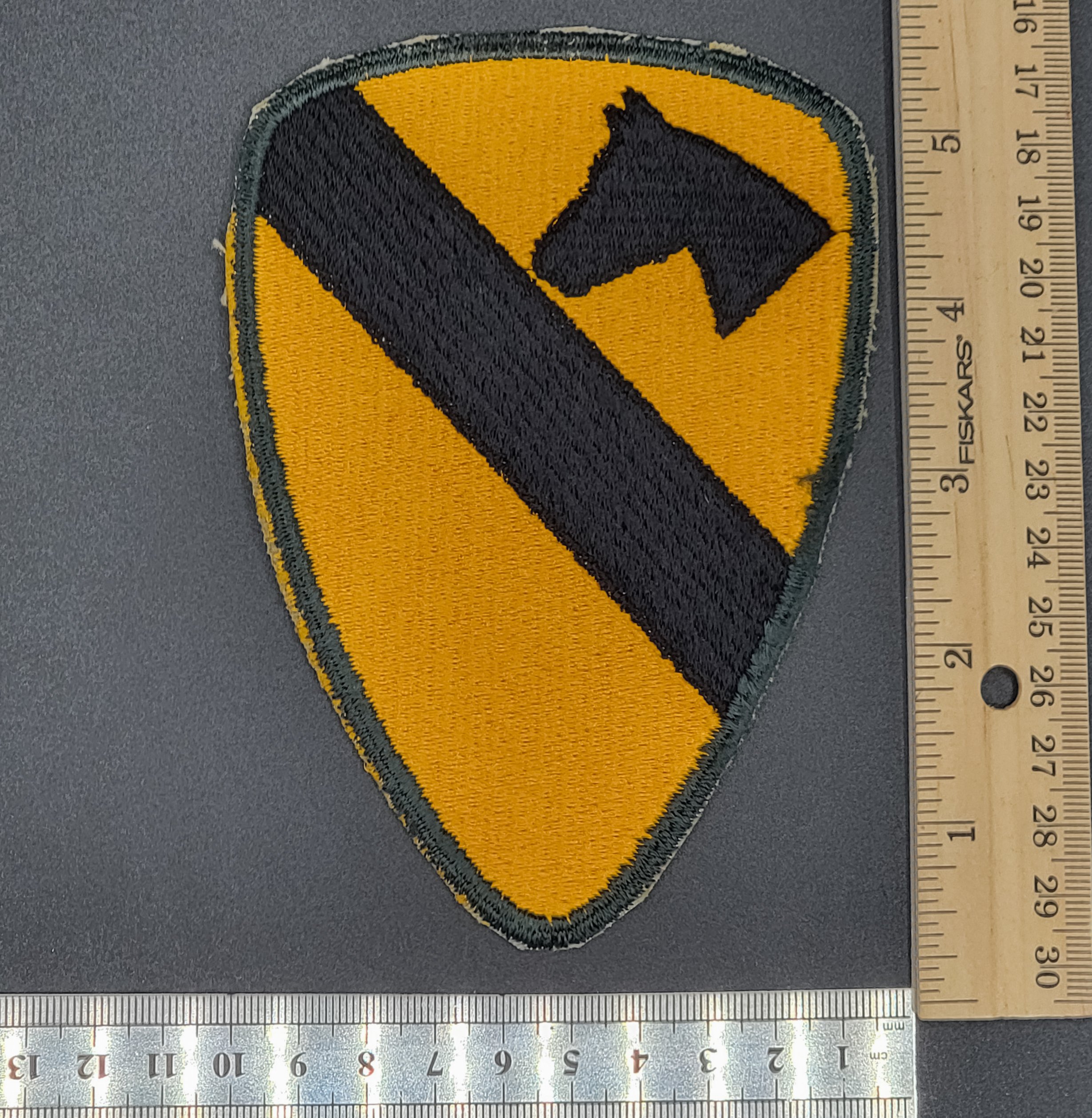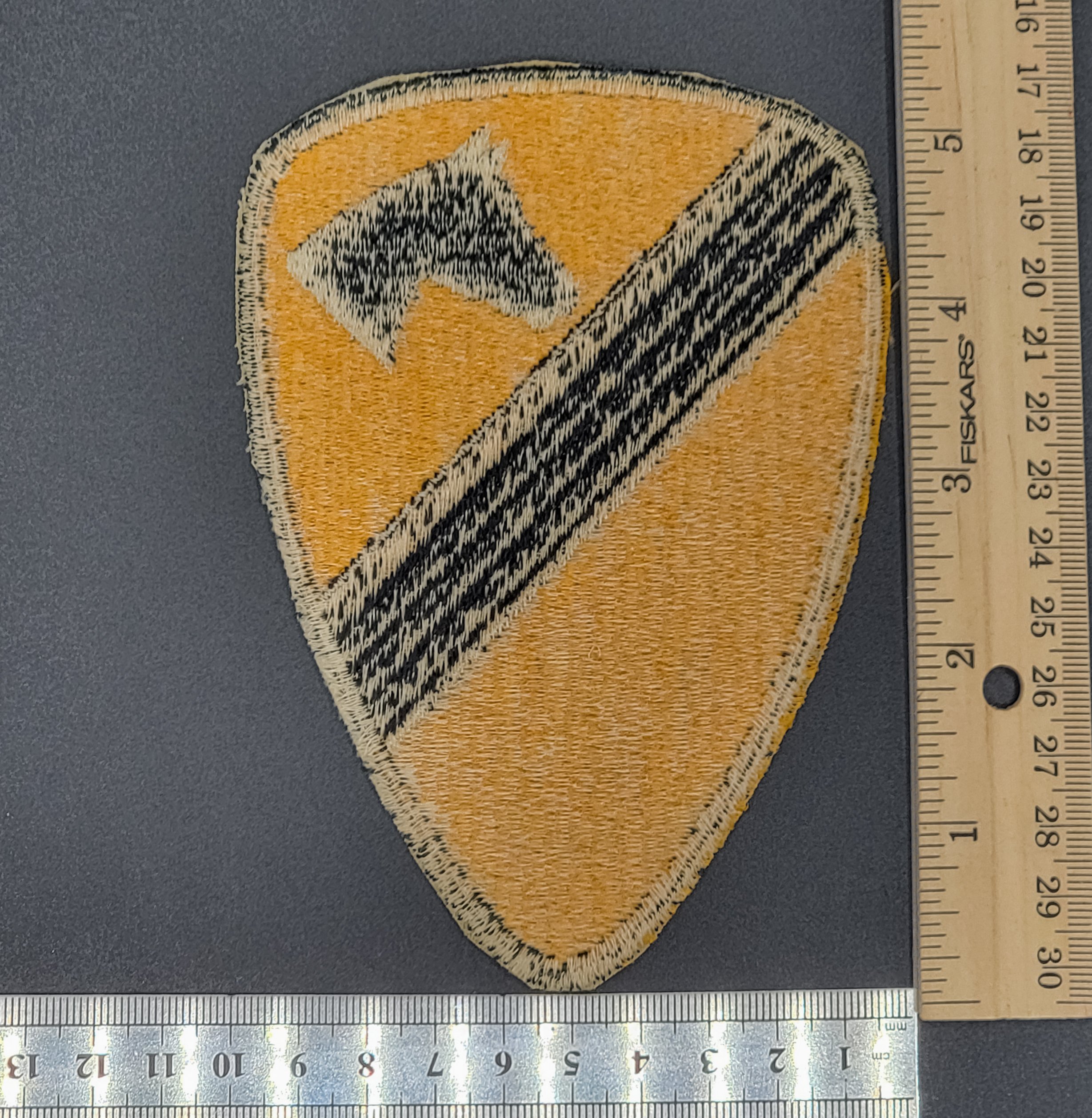1st Calvary Division - OD Border
Although originally part of the III Corps (which eventually participated in the European Theater), while training in the United States, most of the 1st Cavalry Division arrived in Australia as shown above, continued its training at Strathpine, Queensland, until 26 July, then moved to New Guinea to stage for the Admiralties campaign 22–27 February 1944. The division experienced its first combat in the Admiralty Islands, units landing at Los Negros on 29 February 1944. Momote airstrip was secured against great odds. Attacks by the Japanese were thrown back, and the enemy force surrounded by the end of March. Nearby islands were taken in April and May. The division next took part in the invasion of Leyte, on 20 October 1944, captured Tacloban and the adjacent airstrip, advanced along the north coast, and secured Leyte Valley, with elements landing on and securing Samar Island. Moving down Ormoc Valley (in Leyte) and across the Ormoc plain, the division reached the west coast of Leyte on 1 January 1945.
The division then invaded Luzon, landing in the Lingayen Gulf area on 27 January 1945, and fought its way as a "flying column" to Manila by 3 February 1945. More than 3,000 civilian prisoners at the University of Santo Tomas, including more than 60 US Army nurses (some of the "Angels of Bataan and Corregidor") were liberated,[ and the 1st Cavalry then advanced east of Manila by the middle of February before the city was cleared. On 20 February the division was assigned the mission of seizing and securing crossings over the Marikina River and securing the Tagaytay-Antipolo Line. After being relieved on 12 March in the Antipolo area during the middle of the Battle of Wawa Dam, elements pushed south into Batangas and provinces of the Bicol Region together with recognized guerrillas. They mopped up the remaining pockets of resistance in these areas in small unit actions. Resistance was officially declared at an end on 1 July 1945.
Casualties
Total battle casualties: 4,055
Killed in action: 734
Wounded in action: 3,311
Missing in action: 9
Prisoner of war: 1
Although originally part of the III Corps (which eventually participated in the European Theater), while training in the United States, most of the 1st Cavalry Division arrived in Australia as shown above, continued its training at Strathpine, Queensland, until 26 July, then moved to New Guinea to stage for the Admiralties campaign 22–27 February 1944. The division experienced its first combat in the Admiralty Islands, units landing at Los Negros on 29 February 1944. Momote airstrip was secured against great odds. Attacks by the Japanese were thrown back, and the enemy force surrounded by the end of March. Nearby islands were taken in April and May. The division next took part in the invasion of Leyte, on 20 October 1944, captured Tacloban and the adjacent airstrip, advanced along the north coast, and secured Leyte Valley, with elements landing on and securing Samar Island. Moving down Ormoc Valley (in Leyte) and across the Ormoc plain, the division reached the west coast of Leyte on 1 January 1945.
The division then invaded Luzon, landing in the Lingayen Gulf area on 27 January 1945, and fought its way as a "flying column" to Manila by 3 February 1945. More than 3,000 civilian prisoners at the University of Santo Tomas, including more than 60 US Army nurses (some of the "Angels of Bataan and Corregidor") were liberated,[ and the 1st Cavalry then advanced east of Manila by the middle of February before the city was cleared. On 20 February the division was assigned the mission of seizing and securing crossings over the Marikina River and securing the Tagaytay-Antipolo Line. After being relieved on 12 March in the Antipolo area during the middle of the Battle of Wawa Dam, elements pushed south into Batangas and provinces of the Bicol Region together with recognized guerrillas. They mopped up the remaining pockets of resistance in these areas in small unit actions. Resistance was officially declared at an end on 1 July 1945.
Casualties
Total battle casualties: 4,055
Killed in action: 734
Wounded in action: 3,311
Missing in action: 9
Prisoner of war: 1
Although originally part of the III Corps (which eventually participated in the European Theater), while training in the United States, most of the 1st Cavalry Division arrived in Australia as shown above, continued its training at Strathpine, Queensland, until 26 July, then moved to New Guinea to stage for the Admiralties campaign 22–27 February 1944. The division experienced its first combat in the Admiralty Islands, units landing at Los Negros on 29 February 1944. Momote airstrip was secured against great odds. Attacks by the Japanese were thrown back, and the enemy force surrounded by the end of March. Nearby islands were taken in April and May. The division next took part in the invasion of Leyte, on 20 October 1944, captured Tacloban and the adjacent airstrip, advanced along the north coast, and secured Leyte Valley, with elements landing on and securing Samar Island. Moving down Ormoc Valley (in Leyte) and across the Ormoc plain, the division reached the west coast of Leyte on 1 January 1945.
The division then invaded Luzon, landing in the Lingayen Gulf area on 27 January 1945, and fought its way as a "flying column" to Manila by 3 February 1945. More than 3,000 civilian prisoners at the University of Santo Tomas, including more than 60 US Army nurses (some of the "Angels of Bataan and Corregidor") were liberated,[ and the 1st Cavalry then advanced east of Manila by the middle of February before the city was cleared. On 20 February the division was assigned the mission of seizing and securing crossings over the Marikina River and securing the Tagaytay-Antipolo Line. After being relieved on 12 March in the Antipolo area during the middle of the Battle of Wawa Dam, elements pushed south into Batangas and provinces of the Bicol Region together with recognized guerrillas. They mopped up the remaining pockets of resistance in these areas in small unit actions. Resistance was officially declared at an end on 1 July 1945.
Casualties
Total battle casualties: 4,055
Killed in action: 734
Wounded in action: 3,311
Missing in action: 9
Prisoner of war: 1

